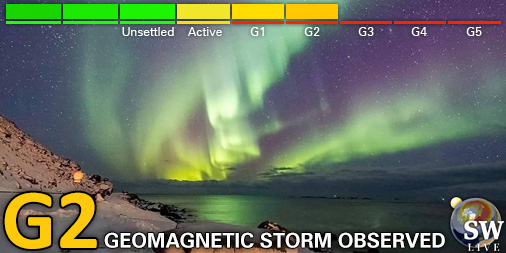Viewing archive of Sunday, 3 January 2021
Daily bulletin on solar and geomagnetic activity from the SIDC
Issued: 2021 Jan 03 1233 UTC
SIDC Forecast
Solar flares
Quiet conditions (<50% probability of C-class flares)
Geomagnetism
Quiet (A<20 and K<4)
Solar protons
Quiet
| 10cm flux | Ap | |
|---|---|---|
| 03 Jan 2021 | 080 | 007 |
| 04 Jan 2021 | 079 | 004 |
| 05 Jan 2021 | 078 | 008 |
Bulletin
Solar activity was at very low levels over the past 24 hours. No significant flares have been recorded. There are currently no active regions on the solar disk as NOAA Active Region 2795 decayed into a plage region and NOAA AR2794 has rotated over the western solar limb. Solar activity is expected to remain at very low levels with no new regions expected to rotate onto the disk.
Three successive filament eruptions were observed in the south-west quadrant of the solar disk, visible in SDO AIA 304 imagery around 21 UT on Jan 01 and at 10 UT and 21 UT on Jan 02, respectively. The first eruption, first visible as a faint south-west Coronal Mass Ejection (CME) in LASCO C2 coronagraphic imagery at 22:04 UT Jan 01, is a slow eruption and appears to be directed mostly south of the Sun-Earth line and is not expected to impact Earth. The second eruption, first visible in LASCO C2 coronagraphic imagery at 11:34 UT Jan 02, is a faster CME with an estimated speed of around 580 km/s and is considered more likely to be Earth-directed, with an estimated arrival time of the afternoon of Jan 05. The third filament eruption, first visible in LASCO C2 coronagraphic imagery at 22:34 UT Jan 02, is directed towards the west and is not expected to impact Earth.
The greater than 10 MeV proton flux was at nominal levels over the past 24 hours and is expected to remain so for the next 24 hours. The greater than 2 MeV electron flux was slightly enhanced but remained below the 1000 pfu alert threshold. The electron flux is expected to remain slightly enhanced over the next 24 hours. The 24h electron fluence was at nominal levels and is expected to remain so over the next 24 hours.
Over the past 24 hours, the solar wind speed fluctuated around 310 km/s (DSCOVR and ACE). The total magnetic field strength ranged between 0 and 4 nT. Bz had a minimum value of -3 nT. The interplanetary magnetic field was predominantly directed towards the Sun (phi angle in the negative sector), but switched to the positive sector from 09:30 UT Jan 03. The solar wind speed is expected to continue to reflect a slow solar wind regime, with a slight enhancement possible on Jan 03 and 04 from the high-speed stream associated with the small positive polarity coronal hole which began to cross the central meridian on Dec 30. The solar wind speed is then likely to increase from Jan 05 in response to predicted arrival of the filament eruption from Jan 02 and due to the the solar wind associated with the two small negative coronal holes which began to cross the central meridian on Jan 02.
Geomagnetic conditions were at quiet levels over the past 24 hours (NOAA Kp and local k Dourbes recorded values of 0-1 and 0-2, respectively). Geomagnetic conditions are expected to be mostly at quiet levels on Jan 03-04, with the possibility of some unsettled periods due to coronal hole influences. On Jan 05, unsettled conditions with the possibility of an active interval may be expected.
Today's estimated international sunspot number (ISN): 000, based on 08 stations.Solar indices for 02 Jan 2021
| Wolf number Catania | /// |
| 10cm solar flux | 082 |
| AK Chambon La Forêt | 003 |
| AK Wingst | 000 |
| Estimated Ap | 001 |
| Estimated international sunspot number | 018 - Based on 14 stations |
Noticeable events summary
| Day | Begin | Max | End | Loc | Strength | OP | 10cm | Catania/NOAA | Radio burst types | |
|---|---|---|---|---|---|---|---|---|---|---|
| None | ||||||||||
Provided by the Solar Influences Data analysis Center© - SIDC - Processed by SpaceWeatherLive
All times in UTC
Current data suggests there is a moderate possibility for aurora to appear at the following middle latitude regions in the near future
Surgut, SyktyvkarCurrent data suggests there is a slight possibility for aurora to appear at the following middle latitude regions in the near future
Kazan, Moscow, Perm, YaroslavlLatest news
Latest forum messages
Support SpaceWeatherLive.com!
A lot of people come to SpaceWeatherLive to follow the Sun's activity or if there is aurora to be seen, but with more traffic comes higher server costs. Consider a donation if you enjoy SpaceWeatherLive so we can keep the website online!

Latest alerts
17:00 UTC - Geomagnetic activity
Moderate G2 geomagnetic storm (Kp6) Threshold Reached: 16:34 UTC
15:30 UTC - Geomagnetic activity
Minor G1 geomagnetic storm (Kp5) Threshold Reached: 15:20 UTC
14:30 UTC - Geomagnetic activity
Strong G3 geomagnetic storm (Kp7) Threshold Reached: 14:18 UTC
13:30 UTC - Geomagnetic activity
Moderate G2 geomagnetic storm (Kp6) Threshold Reached: 13:21 UTC
13:18 UTC - Hemispheric Power Index
The OVATION model predicts the Hemispheric Power Index to reach 125GW at 14:01 UTC
Space weather facts
| Last X-flare | 2025/03/28 | X1.1 |
| Last M-flare | 2025/04/15 | M1.2 |
| Last geomagnetic storm | 2025/04/15 | Kp6+ (G2) |
| Spotless days | |
|---|---|
| Last spotless day | 2022/06/08 |
| Monthly mean Sunspot Number | |
|---|---|
| March 2025 | 134.2 -20.4 |
| April 2025 | 124.1 -10.1 |
| Last 30 days | 124.7 -16.6 |






